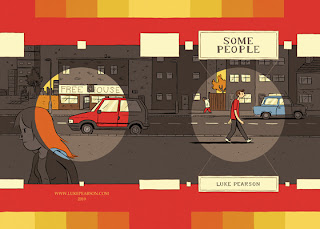Given how rarely it comes out and the unwavering quality of the title, a new issue of Adrian Tomine's Optic Nerve is something of an event. The previous issue was the conclusion to the Shortcomings storyline back in, I think, 2007. Unfortunately this issue has two self-contained stories which suggests that it may be some time before another issue hits the shops. Still let's console ourselves with the issue to hand, and the two main strips within. Two completely different stories which still maintain that feeling of warmth and humanity which the artist manages to convey in virtually all of his work.
The first of these strips, a scene from which adorns the cover, is titled "A Brief History of the Art Form Known as 'Hortisculpture'". A rather clumsy and slightly pretentious title which fits perfectly with the narrative. Harold is a gardener disillusioned with his job who takes an idea from an article about a Japanese artist, and creates a new art form from it that he calls Hortisculpture. Basically it takes sculpture and entwines it with living plants. Well-meaning but not exactly blessed with any artistic talent, Harold is blinded to the folly of his ugly creations and the infeasibility of anybody paying to buy these monstrosities and then paying him a maintenance fee to look after them. Like plenty of people without any real understanding of art he conflates the creation of great (as he sees it) art with great material wealth. Hortisculpture begins to dominate his life, and that of his supportive wife. It is not until he hears his daughter trying to defend his pieces to one of her friends that Harold is able to realise that the idea is a non starter.
Tomine tells this story as if it is a newspaper strip, four panels for six instalments and then a full page colour strip for the seventh. The style he employs also seems somewhat different to previous work but is in keeping with this approach, and it is resolutely still very recognisably him. He skilfully pull this off, the delivery making it seem effortless until one thinks of the amount of work that must have gone in to ensuring that every four panels contained a satisfying story within itself. His use of dialogue to conclude each four-panel instalment is just as impressive, as at the end of a sequence which sees him complaining to his wife in bed after he's just offended her father:
 |
| Different style of art and some sublime dialogue |
Wonderful stuff.
The second of the main strips is called "Amber Sweet" and concerns a young woman who is forced to drop out of college and endures verbal abuse due to the unfortunate fact that she looks like a porn star called Amber Sweet. This is presented in a more traditional comic book form, and Tomine's art here reminds me a lot of Chris Ware without the innovative page design that Ware brings to all his work. It is lovely to look at, but for me this is by far the weaker of the two strips.
The artist appears to be trying to say something about the objectification of women by porn but is rather confused. This is not surprising as it's a difficult area. In some cases it seems obvious that it does, but then what about the women who like porn and who make the films themselves as directors designed to appeal women? As a man it is sometimes difficult to form a coherent conclusion to this subject without feeling that maybe your argument is being tainted by guilt at enjoying possible exploitation. Whatever the reasons, this story feels a little shallow and on rereading is a bit of a disappointment.
The issue is rounded out with a letters page which is very entertaining, including two letters from somebody convinced that Tomine has ripped off his ideas for Shortcomings, and an amusing two page strip showing the respect the single issue comic book form gets now that "graphic novels" have taken off so successfully.
All in all this is an issue that deserves your hard-earned time and money. Even the slightly disappointing Amber Sweet still provides eye candy if you like the ligne-clair style.



